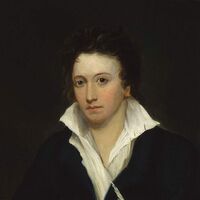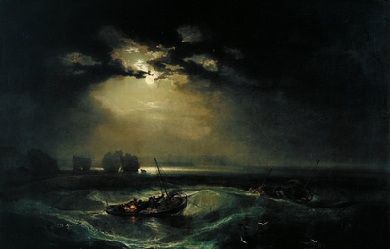
Ozymandias
“Ozymandias” (in five syllables /ˌɒziˈmændiəs/ or four syllables /ˌɒziˈmændjəs/) is a sonnet written by the English romantic poet Percy Bysshe Shelley (1792–1822). First published in the 11 January 1818 issue of The Examiner in London, it was included the following year in Shelley's collection Rosalind and Helen, A Modern Eclogue; with Other Poems (1819) and after his death in a posthumous compilation of his poems published in 1826. "Ozymandias" is regarded as one of Shelley's most famous works and is frequently anthologised.
In antiquity, Ozymandias was an alternative name for the Egyptian pharaoh Ramesses II. Shelley began writing his poem in 1817, soon after the announcement of the British Museum's acquisition of a large fragment of a statue Ramesses II from the thirteenth-century BCE, and some scholars consider that Shelley was inspired by this. The 7.25-ton fragment of the statue's head and torso had been recovered in 1816 from the mortuary temple of Ramesses at Thebes by the Italian adventurer Giovanni Battista Belzoni (1778–1823). It was expected to arrive in London in 1818, but did not arrive until 1821. Shelley wrote the poem in friendly competition with his friend and fellow poet Horace Smith (1779–1849) who also wrote a sonnet on the topic. Smith's poem would be first published in The Examiner a few weeks after Shelley's sonnet. Both poems explore the fate of history and the ravages of time—that all prominent men and the empires they build are impermanent and their legacies fated to decay and oblivion. Shelley and Smith both contrast this fate to the lasting power of art.
Publication history
Both Percy Bysshe Shelley and Horace Smith submitted sonnets on the subject to The Examiner, published by John Hunt in London and edited by his brother Leigh Hunt. Shelley's was published on 11 January 1818 under the pen name Glirastes. It appeared on page 24 in the yearly collection, under Original Poetry. Smith's was published, with the initials H.S., on 1 February 1818. Shelley's poem was later republished under the title "Sonnet. Ozymandias" in his 1819 collection Rosalind and Helen, A Modern Eclogue; with Other Poems by Charles and James Ollier and in the 1826 Miscellaneous and Posthumous Poems of Percy Bysshe Shelley by William Benbow, both in London.
Smith's poem
Percy Bysshe Shelley wrote this poem in competition with his friend Horace Smith, who published his sonnet a month after Shelley's in the same magazine. It takes the same subject, tells the same story, and makes a similar moral point, but one related more directly to modernity, ending by imagining a hunter of the future looking in wonder on the ruins of an annihilated London. It was originally published under the same title as Shelley's verse; but in later collections Smith retitled it "On A Stupendous Leg of Granite, Discovered Standing by Itself in the Deserts of Egypt, with the Inscription Inserted Below”.
Scansion
"Ozymandias" is a sonnet, written in iambic pentameter, but with an atypical rhyme scheme when compared to other English-language sonnets.
Themes
The central theme of "Ozymandias" is contrasting the inevitable decline of all leaders and of the empires they build with the lasting power of art, the only thing that has any permanence.
"Ozymandias" represents a transliteration into Greek of a part of Ramesses' throne name, User-maat-re Setep-en-re. The sonnet paraphrases the inscription on the base of the statue, given by Diodorus Siculus in his Bibliotheca historica, as "King of Kings am I, Osymandias. If anyone should like to know my grandeur and reach of stature, let him surpass any of my achievements."
Shelley's poem may have been inspired by the arrival in London in 1821 of a colossal statue of Ramesses II, acquired for the British Museum by the Italian adventurer Giovanni Belzoni in 1816. The poem was written and published before the statue arrived in Britain, but the reports of the statue's imminent arrival may have inspired the poem. The statue's repute in Western Europe preceded its actual arrival in Britain, and Napoleon had previously made an unsuccessful attempt to acquire it for France.
The verb, "to mock," used in the poem to describe the actions of the sculptor, had two senses. The older sense, "to fashion an imitation of reality" (as in "a mock-up"), existed for several centuries before the poem was written. By Shelley's day the second sense, "to ridicule" (especially by mimicking) had come to the fore.
Cultural influence
The poem has influenced the production of numerous creative works across a range of artistic disciplines. For example, the writer Alan Moore named a superhero Ozymandias, in his 1986-87 comic book miniseries Watchmen and recited the poem in the course of the story. The third-to-last episode of the American television series Breaking Bad, titled "Ozymandias", was directly influenced by the poem's content; the entire poem is also recited by lead actor Bryan Cranston in a trailer for the show's final eight episodes. Woody Allen's films Stardust Memories (1980) and To Rome with Love (2012) use the term "Ozymandias Melancholia", which Allen defines as "the realisation that your works of art will not save you and will mean nothing down the line". Musical works which reference the poem include a setting in Russian for baritone by the Ukrainian composer Borys Lyatoshynsky. In the fifth season of the TV series Mad Men (Dark Shadows) copywriter Michael Ginsberg quotes the line "Look on my works ye mighty, and despair”.


















